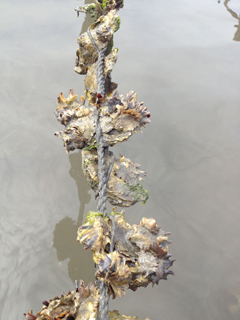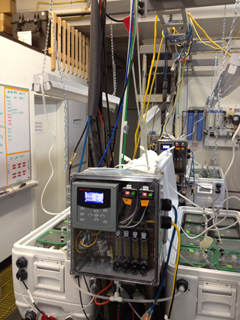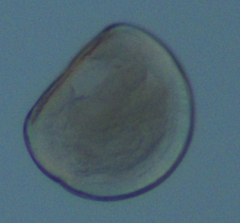Ocean Acidification Makes Life Riskier for Oyster Larvae
Emma Timmins-Schiffman
Look for Tide Bites in your inbox at the start of each month! To view the archive of all previous Tide Bites, visit the FHL Tide Bites page.
Emma recently defended her Ph.D. in the School of Aquatic and Fishery Sciences at University of Washington. She has done much of her research over the last few years at Friday Harbor Labs in the Ocean Acidification Environmental Lab (OAEL). Her post-Ph.D. plans are to do research on protein expression of marine organisms – projects as diverse as microbes colonizing different plastics to the immune response of sea stars – in the Genome Sciences Department at UW. The work described below was accomplished with co-authors Steven Roberts, Carolyn Friedman, Michael “Moose” O’Donnell, Brook Nunn, and Gary Dickinson.
 Figure 1. Young Pacific oysters growing on a line. Photo by Emma Timmins-Schiffman.
Figure 1. Young Pacific oysters growing on a line. Photo by Emma Timmins-Schiffman.
Ocean acidification, the steady decreasing of the ocean’s pH, is a global problem caused by increasing human use of fossil fuels. As we burn more fossil fuels and release more carbon dioxide (CO2) into the atmosphere, more CO2 also enters ocean water, causing reductions in pH. We now know quite a bit about how this affects the chemistry of the open ocean, but many economically and environmentally important species live in the nearshore and intertidal environments where changes to ocean chemistry over the coming years may be less predictable. How will organisms that live in these already variable habitats be affected by ocean acidification and other changes associated with global climate change? We chose to study the Pacific oyster, Crassostrea gigas (Figure 1), as a model to understand the effects of decreased ocean pH (ocean acidification) on intertidal invertebrates.
Animals that live in the shallow water near the shore and in the intertidal experience many fluctuations in environmental pH, temperature, salinity, and oxygen, among other parameters, as the tides rise and fall. This may mean that they are already adapted to some of the environmental changes that we expect to see with global climate change. But natural environmental fluctuations are usually relatively brief – on the scale of hours to maybe days – and the changes foreseen in the coming decades for the global oceans are expected to be more persistent. Will nearshore and intertidal animals have the physiological resources necessary to live and reproduce in their new environment? My Ph.D. research was designed to answer this question.
 Figure 2. Indoor mesocosms of the Ocean Acidification Environmental Lab (OAEL) at FHL. Photo by Emma Timmins-Schiffman.
Figure 2. Indoor mesocosms of the Ocean Acidification Environmental Lab (OAEL) at FHL. Photo by Emma Timmins-Schiffman.First, we looked at how ocean acidification affects early development of oyster larvae. To do that, we used the indoor mesocosms (mesocosm = experimental water enclosure) in the OAEL at FHL. Each mesocosm is a white Igloo cooler containing 8 experimental chambers which are isolated from each other while sharing a common water source and temperature control (Figure 2.) The water which flows through the chambers (and bathed our oysters) is first filtered, sterilized, and stripped of CO2. A digital controller then adds CO2 back into the water to achieve the desired pH. We made seawater at different pHs to mimic what we think future conditions in the ocean might be.
We found that oyster larvae which experienced low pH (high CO2) conditions were developmentally delayed compared to those at normal pH. Oyster larvae are planktotrophic, meaning that they are free-floating in the water column (Figure 3.) If their development is delayed at low pH, they may be exposed to the risky conditions of the open ocean for a longer period of time. It could also mean that when oysters settle and attach that they are smaller than they should be to survive to maturity.
In our next experiment we examined the effects of ocean acidification and a second stress on adult oysters. Since oysters live in a variable environment, they are frequently exposed to multiple stressors at the same time. Does ocean acidification affect how oysters respond to other stressors? We sequenced all of the proteins in the oysters in this experiment and this information gave us insight into physiological changes that occur as an oyster responds to environmental stress. There were many protein-level changes in the oyster in response to ocean acidification alone, including many changes in metabolic pathways, which could signal that the oysters are using resources differently. Perhaps more importantly, the proteomic response to the second stress was significantly altered between the two pH treatments. This means that ocean acidification alters how oysters respond to other sources of environmental change, which could have big implications for how they function in their environment in coming decades.
 Figure 3. A larval oyster, 72 hours after fertilization (72 hpf). Photo by Emma Timmins-Schiffman.
Figure 3. A larval oyster, 72 hours after fertilization (72 hpf). Photo by Emma Timmins-Schiffman.Overall, we found that ocean acidification significantly impacts oysters at multiple stages in their development and that there is cause for concern for nearshore invertebrate populations as the global climate changes. However, we noticed that in both larvae and adults, there was variability in the responses to ocean acidification. This variability may mean that some oysters are able to live normally at low pH and, if this is true, then they may be the ones to carry on the population by adapting to the new ocean conditions. New research in other labs has shown that some invertebrates have a genetic basis to how they respond to ocean acidification, which means that selection for ocean acidification resistance may be possible.
You can find more information, including a list of publications with more details on the work described above, at Emma’s website: students.washington.edu/emmats. Congratulations, Dr. Emma Timmins-Schiffman!



